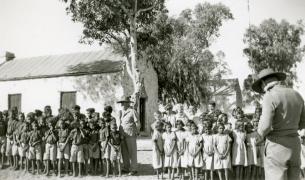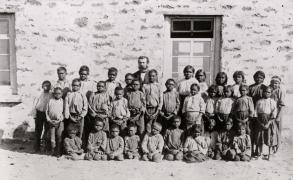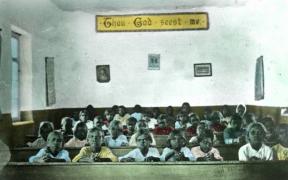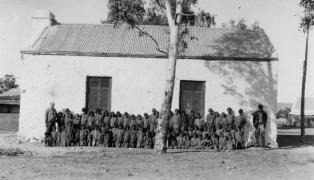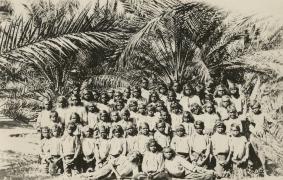Education at Hermannsburg has been a matter of some debate over the years with different policies of the mission, the government and the Arrarnta people all influencing its evolution over the years.
The schoolhouse was the first building erected after Immanuel Synod took over the mission in 1894 under the tenure of Pastor Carl Strehlow and it was used both as a school room and for church services until the second Bethlehem Church was completed.
While the building is currently a serene place to sit, it was no doubt a very different matter when school was in session. Full of sweating children learning their lessons and eager to be released to play. Children lived on the mission in dormitories. Classes were held five days per week initially in the morning between 8.30am and 11.00am. However, by 1950 enrolments had increased to 80 children taught in two groups, one in the morning and one in the afternoon. Classes included reading writing arithmetic, geography history singing and drawing. By 1925 11 subjects were taught in English and five in Arrarnta.
The builder Mr Dave Hart arrived in February 1896 after the foundations had been laid. Hart worked closely with Samuel, originally from Wilyara north east of Alice Springs. The building was opened as a school and temporary church on the 7th June 1896 and continued to be used as a school until 1953.
Two baptisms occurred in this building on the day it opened, that of Isaac, son of Paulus Ebalanga and Lebe; and Benjamin, son of Phillipus Titjinana and Margareta.
Apart from a brief period 1906-1910, when Mr Hillier was employed as a teacher, teaching the children was part of the duties of the missionaries for the first 40 years of the school’s operation. This changed in 1922 when H.A Heinrich was employed as a teacher. He ran the school until 1932. He was followed by Ruth Pech until 1940 when Hilda Wurst took over as teacher and stayed until the new school was built in 1953.
The building is a single room with a fireplace and chimney at the eastern end. The interior walls of this stone building were lime-plastered and whitewashed with the lower sections of the walls painted for use as blackboards. The ceiling was made of calico which stopped dust coming down on the students through the original thatched roof. The roof was later replaced with corrugated iron.
During Albrecht’s tenure residents recall that each weekday morning the children would line up outside the schoolhouse after the teacher had blown a whistle and then they would march into school. The adults on the mission would go about their work to the background sound of children chanting their alphabet and times tables. 1
Changing policies, expectations and standards
The nature and quality of schooling at Hermannsburg has been debated by both the community and outsiders. While early mission records note with pride the schooling provided it seems that there has always been an acceptance that a different standard of education applied to Arrarnta children and the children of the missionaries. Although there is little accessible information from the early years we know that Carl and Frieda Strehlow thought it necessary for their future to send their children to Germany for their education. Many years later when the Australian School of the Air was established the children of missionaries studied remotely by correspondence/wireless, connected with their peers through the wireless radio.
In the 1970s the so called ‘outstation movement’ sought amongst other things to decentralise large Aboriginal communities. During this time Finke River Mission decentralise its school system, moving towards a family school model. The central school became a school for white children while Aboriginal education was delivered in small groups, sometimes on outstations.
A decade later and again education and its mode of delivery was again being hotly debated at Hermannsburg with some Ntaria Community Councillors calling for the establishment of a central school for Arrarnta children living within the Ntaria township. On the 10th August 1983, the Centralian Advocate newspaper reported:
Aboriginal parents and children demonstrated at Hermannsburg’s ‘white’ school on Monday for better educations. Some of the about 100 protestors claimed that their children were getting no teaching at all or were instructed for only a few hours each day…
The protestors gathered outside a building where nine white children were receiving full-time education, Gus Williams, chairman of the Settlement’s Ntaria Council, said there should be a central school for the 100 or so children living in the township and the numerous outstation classes should provide full-time teaching.
In 1984 a compromise was reached with a central school at Ntaria provided for up to 45 students while the family schooling model preferred by many families continued alongside it. Finke River Mission continued to provide education in this way until 1989. At that time, they were forced to withdraw from providing schooling at Hermannsburg due to rising costs; as government subsidies no longer covered teachers’ salaries and other costs associated with delivering education in remote locations such as Hermannsburg.
- Henson B 1992 A Straight Out Man, Melbourne University Press p 21
- Bonner 1980 cited in Albrecht P. From Mission to Church, 1977-2002, Finke River Mission. p112.
- Collins 1999:2 cited in Albrecht P. From Mission to Church, 1977-2002, Finke River Mission. p103.
Media
